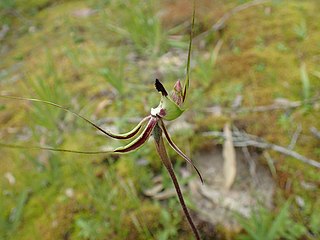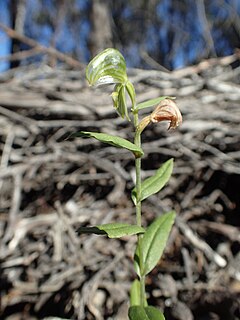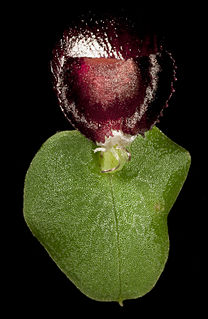
Caladenia exstans, commonly known as the pointing spider orchid, is a species of orchid endemic to a small area in the south-west of Western Australia. It has a single, hairy leaf and one or two green, yellow and red flowers with a labellum which does not curl downwards but "points" forward.

Caladenia falcata, commonly known as the fringed mantis orchid, is a species of orchid endemic to the south-west of Western Australia. It is a relatively common orchid within its natural range and has a single, hairy leaf and one or two green, yellow and red flowers with spreading petals and upswept lateral sepals.
Caladenia validinervia, commonly known as the Lake Muir spider orchid, is a species of orchid endemic to the south-west of Western Australia. It has a single erect, hairy leaf and up to three greenish to creamy white flowers with red stripes on the sepals and petals. The flowers have relatively narrow sepals and petals and a relatively small labellum. It is a rare orchid only known from an area between Rocky Gully and Collie.
Caladenia cadyi is a plant in the orchid family Orchidaceae and is endemic to the south coast of New South Wales. It has a single dull green leaf with purple blotches near the base, and a single greenish cream to cream flower with pink to reddish markings. It was only known from a single population which has been bulldozed and replaced with a pine plantation so that it is now probably extinct.
Caladenia ensigera is a plant in the orchid family Orchidaceae and is endemic to South Australia. It is a ground orchid with a single leaf and one or two greenish cream to whitish green flowers and is only known from Alligator Gorge in the Mount Remarkable National Park.
Pterostylis ciliata, commonly known as the hairy rufous greenhood, tall rusthood or hairy rustyhood is a plant in the orchid family Orchidaceae and is endemic to the south-west of Western Australia. It has a relatively large rosette of leaves at its base and up to eight or more green and brown flowers which lean forward and have a small, fleshy, insect-like labellum covered with hairs.

Pterostylis leptochila, commonly known as the Ravensthorpe rufous greenhood or narrow-lipped rustyhood is a plant in the orchid family Orchidaceae and is endemic to the south-west of Western Australia. Both flowering and non-flowering plants have a relatively large rosette of leaves. Flowering plants also have up to five large translucent white flowers with olive green and brown lines and markings and a narrow, insect-like labellum.

Caleana nigrita, commonly known as the small duck orchid or flying duck orchid is a species of orchid endemic to the south-west of Western Australia. It is the most common of the flying duck orchids and has the widest distribution of the Western Australian species. It has a single smooth leaf and is distinguished from the others by its labellum which has a hump in the middle and calli covering two thirds of its outer end. Its dull colouration makes it difficult to find, especially in areas that are blackened by fire.
Microtis familiaris, commonly known as the coastal mignonette orchid or coastal onion orchid is a species of orchid endemic to the south-west coastal region of Western Australia. It has a single hollow, onion-like leaf and up to twenty small, green to greenish-yellow, sweetly scented, widely spaced flowers. It often grows with large populations of other Microtis orchids but only flowers after fire.
Corybas abditus, commonly known as the swamp helmet orchid or small helmet orchid , is a species of terrestrial orchid endemic to Western Australia. It is a rare orchid with a single bluish green, heart-shaped leaf and a small flower with an enlarged dorsal sepal and tube-shaped labellum.

Corybas acuminatus, commonly known as the dancing spider orchid or helmet flower, is a species of terrestrial orchid endemic to New Zealand. It has a triangular, sharply pointed leaf and a small translucent, greenish-white flower with purple markings and with very long sepals. It is found on both the main islands of New Zealand and also some of the off-shore islands.

Corybas barbarae, commonly known as fairy lanterns, is a species of terrestrial orchid endemic to eastern Australia including Lord Howe Island. It has a single dark green or reddish green, heart-shaped leaf and a small sparkling white or pinkish flower with an inflated dorsal sepal obscuring its hairy labellum.

Corybas despectans, commonly known as the tiny helmet orchid or sandhill helmet orchid is a species of terrestrial orchid endemic to southern Australia. It has round or heart-shaped leaf and a tiny reddish purple flower. Unlike many others in the genus, the dorsal sepal does not cover the labellum. It is similar to C. incurvus but the flowers are smaller.
Corybas dowlingii, commonly known as red lanterns, is a rare species of terrestrial orchid endemic to New South Wales. It grows in colonies and has a round or heart-shaped leaf and a dark purplish red flower with white patches in the labellum.
Corybas expansus, commonly known as the flared helmet orchid, is a species of terrestrial orchid endemic to South Australia. It has a heart-shaped to more or less round leaf and a single purplish flower with greenish or transparent areas. It is a vulnerable species, found in near-coastal sand and leaf litter.

Corybas incurvus, commonly known as the slaty helmet orchid, is a species of terrestrial orchid endemic to south-eastern Australia. It has a broad egg-shaped to heart-shaped leaf and a dark purple flower with a white patch in the middle.
Corybas × miscellus, commonly known as the hybrid helmet orchid, is a hybrid species of terrestrial orchid endemic to South Australia and a very small area in far western Victoria. It has a heart-shaped to more or less round leaf and a single reddish purple flower with greyish translucent areas. It is a natural hybrid between C. diemenicus and C. incurvus and shares the characteristics of the parent species.
Corybas montanus, commonly known as the montane helmet orchid, is a species of terrestrial orchid endemic to Queensland. It forms small colonies and has single heart-shaped to round leaf and a reddish, self-pollinating flower with a curved dorsal sepal. It is only known from the Mount Barney National Park in south-east Queensland.

Corybas recurvus, commonly known as the western helmet orchid or common helmet is a species of terrestrial orchid endemic to Western Australia. It has round or heart-shaped leaf and a dark reddish purple or purplish black flower. It is widespread and common between Bunbury and Albany.
Calochilus uliginosus, commonly known as the swamp beard orchid, is a species of orchid endemic to Western Australia. It has a single dark green leaf with a reddish purple base and up to seven greenish to brownish flowers with red lines and a labellum with a reddish purple beard.









